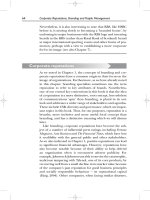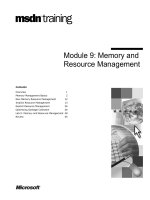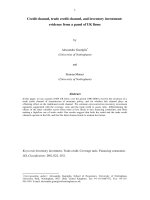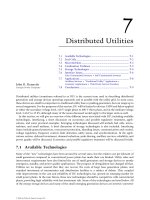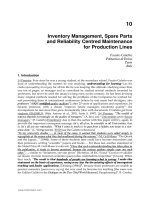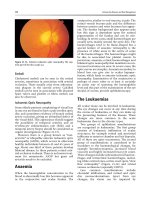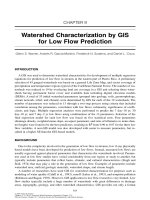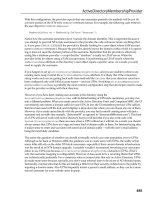Chương 9 Channel and Inventory Management
Bạn đang xem bản rút gọn của tài liệu. Xem và tải ngay bản đầy đủ của tài liệu tại đây (63.67 KB, 7 trang )
CHƯƠNG 9: Channel and Inventory
Management
1. Hospitality Inventory Warehouse
Hospitality Inventory Warehouse is a system for organizing
and tracking inventory of products and services related to
tourism, resorts, dining, entertainment,...
It can be visualized as a distribution network, a warehouse with
rows of shelves filled with inventory including products and
services. The entire inventory organization is stored on these
shelves by date.
Example: online (Travelocity, Expedia...), offline (travel
agencies, wholesalers) and specific types of services (event
organizations). event, group, combo package, card
membership,...).
Each bin holds varying amounts of inventory depending on the
day and expected demand.
Intuitive and efficient inventory management in the hospitality
industry.
Suppose there are 10 boxes for the Travelocity channel
and 6 boxes in the promotions channel, on the same day.
The Travelocity box sold out first, but there are still
customers booking rooms for this channel.
=> Organizations need to consider many factors before
deciding whether to "save" a channel that is out of stock or not.
Racking and bin systems help visualize inventory status and
support decision making.
This is a consequence of booking rooms exceeding the
organization's prescribed level, also known as the phenomenon
of "overbooking" inventory.
Consequences of "stuffing" inventory:
Loss of organizational reputation:
Increased pressure on employees:
Reduced service quality
How to avoid "cramming":
More accurate demand forecasting
Strictly control reservations
Develop a clear overbooking handling process
Analyze channel and warehouse management
Effective channel and warehouse management is an important
factor in the tourism and hospitality industry. By analyzing
demand, determining distribution channels, and allocating
resources appropriately, organizations can optimize revenue,
attract target customers, and enhance customer experience.
Optimize revenue in the warehouse system according to
distribution channels
Warehouse management activities:
Change initial allocation:
Adjusting the price of each box:
=> Flexible inventory allocation, tracking and adjustment can
help make the most of sales opportunities. Automated
technology can support management but cannot completely
replace the human role in making strategic decisions.
The importance of combining computer systems and human
intelligence in channel and inventory management.
The management process takes place on each specific day:
Identify target customers
Demand forecast
Optimize business structure
Choose distribution channels
Determine price
Stock allocation
The challenge and importance of optimizing inventory
allocation day by day in revenue management.
Predicting the future is difficult
Allocation across complex channels
Prevent too much human intervention
Gist:
Optimizing inventory allocation on a daily basis is a key
factor in maximizing revenue.
Forecasting demand and distributing across multiple
channels is complex due to the uncertainty of the future
and the many influencing factors.
Technology is developing tools that support more accurate
and automated inventory allocation, aiming to reduce
reliance on human intervention.
2. Nonelectronic Channel Management
Products should always be available to customers who prefer to
purchase hotel products and services through traditional or
non-electronic methods. And there are 3 methods:
The first traditional method of making a reservation is via
the telephone.
A consumer may also wish to make a reservation via fax,
mailed-in request form, or via email contact. This is the
second method
And finally, employees at physical purchase locations
such as ticket counters of airlines, car rental agencies, and
venues.
3. Electronic Channel Management
SL1
The first place an organization should begin in developing its
electronic channel management plan is with its
proprietary website.
Review and critically assess its website from the booking
customer’s point of view:
=> Highlight deficiencies and opportunities for the
organization to capture more business.
Critical elements in the organization’s revenue management
strategy:
Develop a plan for managing inventory through its central
reservation system.
Capturing customer information through its property
management system.
SL2
Next, the organization should assess its management of the
inventory it provides to the online, or merchant model,
sites.
The online sites would not exist without inventory being
provided by the hospitality organizations.
The organization should also build strong relationships with the
referral sites, such as Kayak, Mobissimo, or SideStep.
A pay per click fee is a small fee assessed for each time a
consumer clicks to access a specific site.
SL3
How in the world an organization finds out about special
interest sites that may be visited by targeted customers?
First, the organization should use all of its internal data on
the customer to mine for information.
“Data mining is the process of digging through layers of data
and filtering out applicable information.”
Second, volumes of guest information are available from
consumer purchases made.
4. Price Parity
Definition:
Price parity is a policy adopted by many organizations to
address issues related to disparate pricing across different
distribution channels
Purpose:
Maintain uniform pricing for the same type of inventory or
service across various sales channels
Eliminate discrepancies in prices that customers may
encounter when accessing a product or service through
different
Price parity is particularly relevant in industries such as
hospitality, travel, and e-commerce, where products and
services are often offered through multiple channels.
5. Cross-Channel Behavior
Customers frequently engage with multiple channels when
making a purchase.
For instance, travelers may initially check a hotel or airline's
site for availability and then explore online merchants to find
the best rates.
Purpose:
Understanding and analyzing consumer behavior across
different channels is crucial for organizations to tailor their
strategies effectively and enhance the overall customer
experience.
6. Customer Ownership
The issue of customer ownership arises in scenarios where a
product or service is sold through intermediaries.
Benefits:
Customer Loyalty: By actively managing and owning the
customer relationship, businesses can build stronger
connections with their customers. Customers are more
likely to continue engaging with a brand they have a
positive and consistent experience with.
Repeat Business: Customer ownership strategies aim to
encourage repeat business. Satisfied customers are more
likely to choose the same brand for their next purchase.
Brand Advocacy: Satisfied customers who feel a sense of
ownership and positive engagement with a brand are
more likely to become advocates. They may recommend
the brand to others, leading to organic word-of-mouth
marketing and increased brand awareness.
Customer Satisfaction: Owning the customer relationship
allows businesses to proactively address customer needs,
concerns, and feedback. This can result in higher levels of
customer satisfaction as businesses can tailor their
offerings and services based on customer preferences and
expectations.
Competitive Advantage: Offering a seamless and positive
customer experience sets a brand apart from competitors
and can be a significant factor in customer decisionmaking.
Effective Communication: . This allows for more effective
and personalized communication, leading to better
understanding of customer needs and preferences.
Data Utilization: Customer ownership often involves
collecting and analyzing customer data. Businesses can
leverage this data to gain insights into customer behavior,
preferences, and trends. This information can inform
strategic decisions, product development, and marketing
efforts.
Adaptability: The direct connection with customers allows
for quicker adjustments to meet evolving demands.
Reduced Dependence on Intermediaries: Establishing a
direct relationship with customers provides more control
over the customer experience and business operations.
7. Competitive Analysis of Price and Inventory
Competitive analysis of prices and inventory is the act of
tracking, observing and analyzing competitors' prices and
goods so that a business can set prices and allocate inventory
over a period of time.
8. Inventory Management Process Per Channel
9. The key elements to consider in this process are:
Pricing
Unit availability
Purchasing rules and restrictions
The most common inventory controls are:
Closed to arrival
Minimum length of stay
Maximum length of stay
Must stay
Full pattern length of stay

